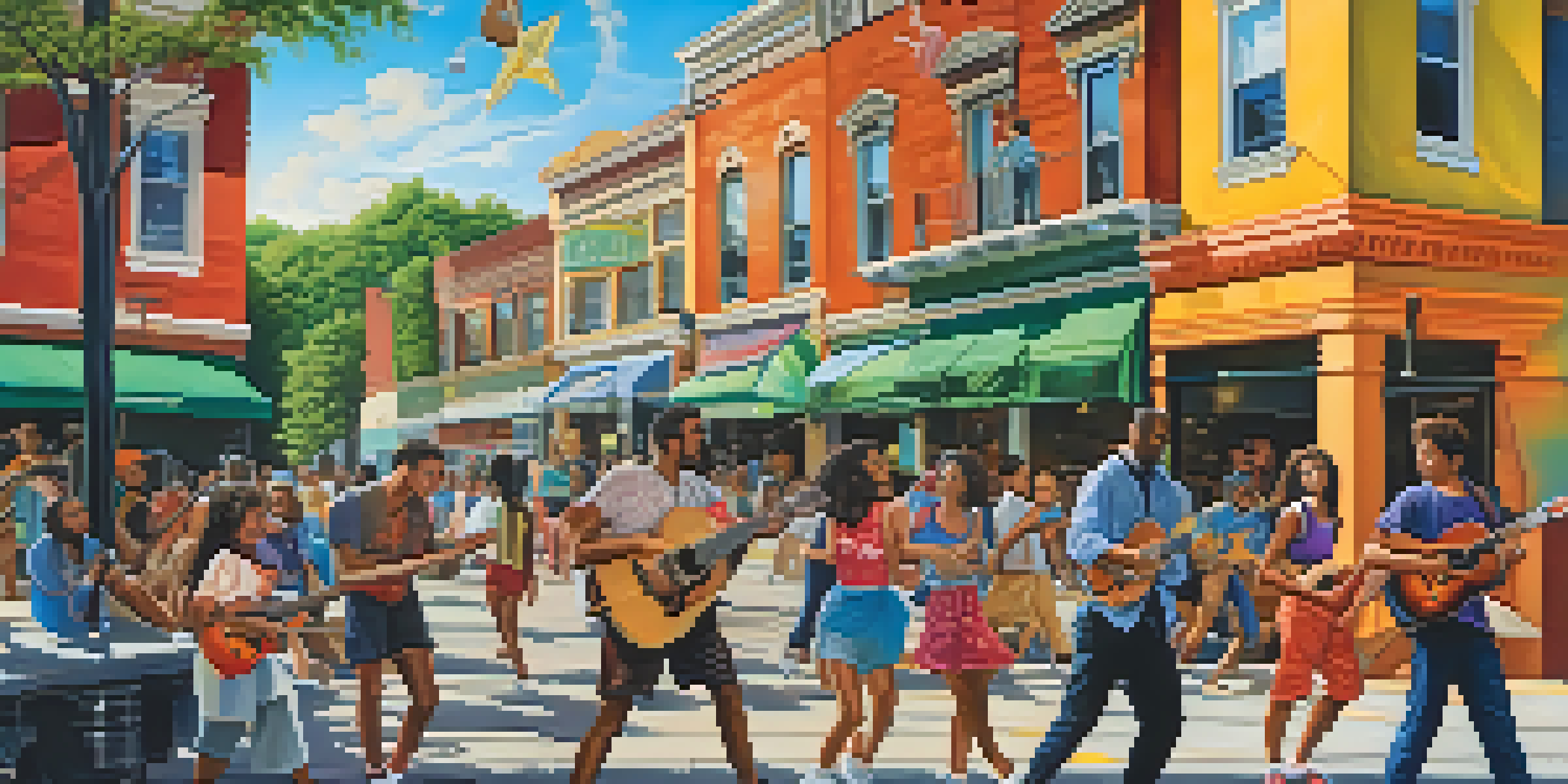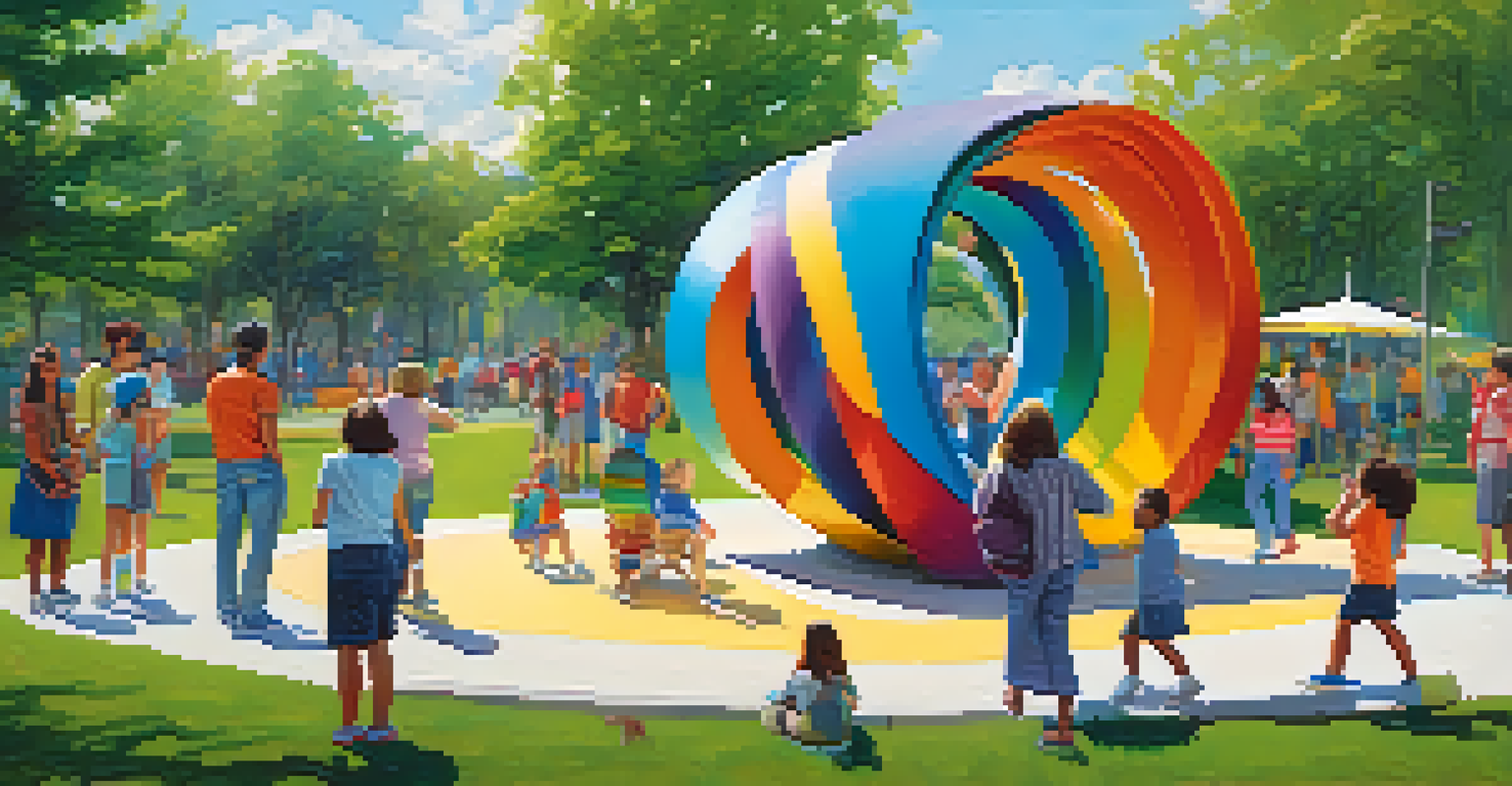Exploring Public Art Initiatives: Transforming Urban Landscapes

The Rise of Public Art in Urban Spaces
Public art has become a vibrant part of urban landscapes, breathing life into once dull areas. From murals to sculptures, these art forms create a sense of identity and belonging for local communities. As cities grow, the need for creative expressions in public spaces has surged, transforming streets and parks into open-air galleries.
Public art is a reflection of the community; it tells the stories that need to be told.
This resurgence reflects a broader cultural shift towards valuing creativity and community engagement. Cities are increasingly recognizing that public art can enhance not only aesthetics but also social cohesion. The integration of art into urban planning invites residents to participate in their environment, fostering a sense of pride.
Moreover, public art initiatives often attract tourism and boost local economies. Visitors are drawn to unique installations, providing opportunities for local businesses to thrive. As a result, cities investing in public art see long-term benefits beyond immediate visual appeal.
Engagement Through Interactive Art Installations
Interactive art installations are redefining how we engage with public spaces. These projects invite participation, allowing individuals to become part of the artwork itself. This engagement not only enhances the viewing experience but also encourages community interaction and collaboration.

For example, installations that respond to movement or sound can transform a passive viewing into an active experience. Participants might contribute to a mural or manipulate elements of a sculpture, fostering a deeper connection to the artwork. This hands-on approach helps demystify art, making it accessible to everyone, regardless of their background.
Public Art Boosts Community Pride
Public art transforms urban spaces into vibrant representations of local identity, fostering a sense of belonging and pride among residents.
Additionally, these interactive pieces often spark conversations among participants, creating a shared experience. This dialogue can bridge gaps between diverse communities, promoting inclusivity and understanding. Ultimately, interactive art serves as a catalyst for community building.
Public Art as a Tool for Social Change
Public art initiatives often address important social issues, making art a powerful tool for advocacy. Through thought-provoking visuals and messages, artists can raise awareness about topics like climate change, social justice, and mental health. This ability to spark conversation can lead to meaningful change within communities.
Art is the most beautiful of all lies; it allows us to express the inexpressible and connect with each other.
For instance, murals depicting local heroes or addressing historical injustices can inspire pride and provoke dialogue. These artistic expressions prompt viewers to reflect on their surroundings and the issues that affect their lives. By placing these topics in public view, artists contribute to a broader cultural discourse.
Moreover, public art can serve as a form of protest, galvanizing communities to respond to societal challenges. When art reflects the struggles and aspirations of a community, it empowers residents to take action, fostering a sense of unity and purpose. This transformative power of art highlights its role beyond mere decoration.
Creating Inclusive Spaces Through Public Art
Inclusivity is a key consideration in public art initiatives, aiming to represent diverse voices and experiences. Artists are increasingly collaborating with local communities to ensure that their work reflects the demographics and stories of the area. This approach not only enriches the artwork but also fosters a sense of ownership among residents.
For example, community-driven projects often involve workshops where residents can share their stories and ideas. This collective input allows for a more authentic representation of the community's identity. By prioritizing inclusivity, public art initiatives can break down barriers and promote understanding among different groups.
Interactive Art Engages Communities
Interactive art installations invite community participation, creating shared experiences that promote dialogue and inclusivity.
Additionally, inclusive public art can create safer spaces for marginalized communities. When art represents and celebrates diversity, it invites people to engage and feel welcome. Ultimately, these initiatives contribute to a richer, more harmonious urban environment.
The Role of Technology in Modern Public Art
Technology is playing an increasingly prominent role in public art, pushing the boundaries of creativity. Digital installations, augmented reality, and projection mapping are just a few examples of how tech is transforming urban landscapes. These innovations allow artists to create immersive experiences that captivate audiences in new ways.
For instance, augmented reality apps can enhance traditional murals by overlaying digital animations, engaging viewers in a multi-sensory experience. This fusion of art and technology not only attracts younger audiences but also opens up new avenues for storytelling. As a result, urban art is evolving to meet the expectations of a digitally-savvy generation.
Moreover, technology enables artists to reach broader audiences, transcending geographical barriers. Virtual exhibitions and online platforms allow people from all over the world to experience public art. This accessibility fosters a global appreciation for local art, enriching the cultural landscape.
Challenges Faced by Public Art Initiatives
Despite the numerous benefits, public art initiatives often face significant challenges. Funding remains a critical issue, as many projects rely on grants, sponsorships, or community donations. Securing resources can be a daunting task, particularly for smaller organizations trying to make an impact.
Additionally, navigating bureaucratic processes can hinder the implementation of public art projects. Permits, zoning laws, and community approval can slow down progress and stifle creativity. Artists and organizers must often balance their vision with the requirements imposed by city officials, which can lead to compromises.
Art as a Catalyst for Social Change
Public art addresses critical social issues, empowering communities to engage in meaningful conversations and advocacy.
Finally, public reaction to art can be unpredictable. What resonates with some may not appeal to others, leading to debates about taste and appropriateness. This variability highlights the importance of community involvement in the planning stages, ensuring that diverse perspectives are considered.
The Future of Public Art Initiatives
Looking ahead, the future of public art initiatives appears promising, with increasing recognition of their value. Cities are beginning to integrate art into their development strategies, acknowledging its potential to enhance quality of life. This trend suggests a growing commitment to fostering creativity within urban environments.
Moreover, as communities continue to advocate for representation and inclusivity, public art is likely to evolve in response. Artists will increasingly collaborate with residents to create works that resonate with diverse experiences. This shift can lead to a richer tapestry of narratives, reflecting the complexities of contemporary urban life.

Ultimately, the future of public art lies in its ability to adapt and respond to societal changes. As technology advances and communities evolve, public art will continue to play a vital role in shaping urban landscapes, fostering connection, and inspiring change.